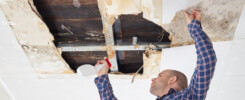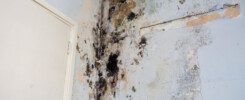Florida home and business owners are certainly at risk of sustaining water damage to their property. The second most common reason for filing a property damage claim in Florida is water damage.
Water damage is a serious emergency that requires direct attention. You’ll only risk potential health issues and compound damage by delaying your reaction.
Once you’ve experienced water damage to property, there are immediate and essential steps to take.
1. Stop the Source
The moment you notice water intrusion has occurred, it’s vital to investigate, find the source, and stop further damage. The most common causes are a fault in a water supply line, a compromised roof, plumbing fixture malfunctions, and A/C unit faults.
Once you’ve determined the source of the water, choose the proper mitigating factor(s) such as:
- Shutting off the main water supply to the home or building
- Placing waterproof tarps on the roof in damaged area(s)
- In the event of potential flooding, making use of sandbags around the perimeter of the property
2. Contact Your Insurance Provider
The insurance company needs to be the first to know in the event that you need water damage repair. They will be able to inform you of the proper protocol to ensure that you are adequately compensated for losses and damages covered by your policy.
Tips for communicating with your company:
- Keep policy information and agent contacts readily available
- Document as much as possible by taking pictures as safety allows
- Schedule an appointment with a claims adjuster
3. Protect Your Possessions
If the property contains items you want to salvage quickly, consider entering to retrieve them. Prioritize electronics, important documents, and sentimental personal items.
When planning to enter an area with standing water:
- Shut off the main electrical supply to the area
- Wear protective outerwear like rubber boots and gloves
- Plan to minimize trips into the area until drying and cleaning start
4. Begin Drying
It’s possible to accelerate the drying process. If there is an excess of standing water, use buckets to transport it out of the space. A wet-dry vacuum or push brooms and mops are also valuable for eliminating water.
Any wet or damp furniture should be removed, along with rugs or other materials that could harbor mold and mildew.
5. Identify Mold
If water has been present for 24 hours or more, there is a higher likelihood that mold will develop. What’s worse is that it will not stop once it has begun to grow. Involving a professional to aid in identifying and removing mold is the optimal, safe choice.
The most common signs of mold are:
- Rotten or general musty smell
- Discolorations on walls and ceilings in a waterline pattern
- Splotches of green, brown, or black
- Discolored patches that have a velvety looking texture
- Physical symptoms such as sneezing, coughing, itchy throat, congestion
6. Assess Damage
There are varying degrees of damage, and each will require its own process for cleaning, repair, and restoration. Once the water has subsided, you can see the extent of the damage to the structure. Floors, walls, ceilings, and appliances can sustain significant damage and should be inspected carefully.
7. Begin Repair and Restoration
A professional restoration and mold remediation company is your most important ally for water damage repair. They’ll have high-quality drying equipment and a well-developed plan of action.
In some cases, flooring and wall or ceiling material will need to be replaced entirely.
8. Confirm It’s Safe to Return
Your insurance company, water restoration company, and mold remediation specialist will be your resources for ensuring a safe return to your building or home. In the case of a natural disaster, your local government will provide updates on when individuals can return to their property.
Tips for a safe return:
- Observe all government emergency service announcements
- Ensure the water intrusion has not compromised the integrity of the structure
- Consult the experts you’ve enlisted and review repair and restoration measures
Don’t Wait to Act on Water Damage
Water damage to business or home needs swift action, and repairing water damage can be complicated and even overwhelming without help. If you’ve been the victim of water damage at your home or business, contact us today for a full assessment and action plan.


